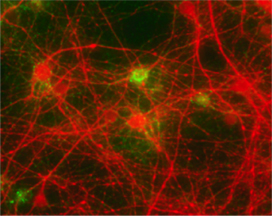Human genetic and pathologic studies implicate a number of proteins in neurodegenerative diseases. These include alpha-synuclein in synucleinopathies that include Parkinson disease, multiple system atrophy, dementia with Lewy bodies and other rarer diseases; beta-amyloid peptide in Alzheimer disease; TDP-43 in frontotemporal dementia and ALS (Lou Gehrig’s disease); and Huntingtin in Huntington disease. All of these proteins are toxic when expressed in yeast. Toxicity is robust with high signal-to-noise that is amenable to high-throughput screening. Importantly, we find these proteins result in distinct cytotoxicity. Indeed our unbiased platform has identified a number of known human genes implicated in these various diseases.
While yeast offers a tremendously powerful discovery platform for unbiased functional genomics and drug discovery, there is clearly a need to establish the relevance of our findings in neurons. Over the last few years we have developed expertise for secondary validation of our gene and small molecule hits in cortical neurons. Cortical neurons become dysfunctional and are lost in diseases such as Alzheimer disease, Parkinson disease, dementia with Lewy bodies, frontotemporal dementia and Huntington disease. We generate cortical neurons in two ways. First, we generate primary rat cortical culture by dissecting cortices from embryonic rats at day E18. As the cells mature, they are either transduced with viruses that carry neurodegenerative disease-related proteins, or exposed to exogenous toxic oligomers of these proteins. Toxicity is measured by assays for neuronal markers or by measuring cellular ATP content.
More recently, we have begun to generate cortical neurons from patients by differentiating induced pluripotent stem (iPS) cells into these cells. For example, in collaboration with the Jaenisch lab, we established iPS cell lines from a patient with Parkinson disease who harbored the A53T alpha synuclein mutation (Soldner et al. 2011). Importantly, an isogenic mutation-corrected line was established to generate an ideal control for this patient’s line. Characterization of these stem cell-derived neurons are now underway in our lab.



